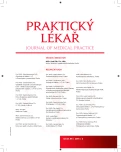Trends in obesity and physical activity in Czech pre-schoolers between 2005 and 2015
Authors:
E. Sigmund; L. Trhlíková; D. Sigmundová; P. Baďura
Authors‘ workplace:
Institut aktivního životního stylu
; Vedoucí: prof. PhDr. Karel Frömel, DrSc.
; Univerzita Palackého v Olomouci Fakulta tělesné kultury
Published in:
Prakt. Lék. 2016; 96(2): 71-76
Category:
Of different specialties
Overview
Objective:
The aim of study was to explore the trends in prevalence of obesity and pedometer-determined physical activity (PA) in Czech 4–7-years old preschool children from 2005 to 2015.
Methods:
The cross-sectional study in two cohorts of preschool children carried out during spring and autumn 2005 (11 kindergartens: 84 girls and 92 boys) and 2015 (10 kindergartens: 87 girls and 105 boys), using the same measurements and procedures in both cases. PA were monitored by unsealed pedometer Yamax digiwalker SW-200 at least 8 continuous hours a day over 7 consecutive days. Body weight and height was measured using calibrated scales Tanita WB 110 S MA and Antropometer A-319.
Results:
In the prevalence of obesity was observed non-significant increase between 2005 and 2015 for girls (7.14%2005 vs. 9.20%2015) and boys (6.52%2005 vs. 9.52%2015). PA (mean steps/day) was significantly higher (p < 0.05) in the total cohort of preschool children in 2015 than in 2005 (11,739 vs. 10,922 steps/day) and overall (p < 0.001) in boys than girls (11,939 vs. 10,668 steps/day). Decline of leisure time step counts in weekdays between 2005 and 2015 in girls (6,8652005 vs. 6,0592015, p < 0.01) and boys (7,8612005 vs. 6,4362015, p < 0.001) is compensated by the increase of step counts in kindergarten (girls: 3,0582005 vs. 5,3302015, p < 0.001; boys: 4,0032005 vs. 5,9992015, p < 0.001).
Conclusions:
Despite a small, non-significant increase in obesity among Czech preschool children remains the prevalence (< 10%) to healthy acceptable level. Daily PA programme in kindergartens effectively replaces the decline in PA in leisure time of weekdays and even helps to increase a weeklong PA of pre-schoolers compared to 2005 and 2015.
Keywords:
obesity – trend – physical activity – pedometer – weekdays – weekend
Sources
1. Brusseau TA, Kulinna PH, Tudor-Locke C, et al. Pedometer-determined segmented physical activity patterns of fourth - and fifth-grade children. J Phys Act Health 2011; 8(2): 279–286.
2. Cohen J. Statistical power analysis for the behavioral science. 2nd ed. Erlbaum: Hillsdale NJ 1998.
3. De Craemer M, Lateva M, Iotova V, et al. Differences in energy balanced-related behaviours in European preschool children: The ToyBox-Study. PLoS ONE 2015; 10(3): 1–18. Dostupné z: http://dx.doi.org/10.1371/journal.pone.0118303.
4. De Onis M, Blössner M, Borghi E. Global prevalence and trends of overweight and obesity among preschool children. Am J Clin Nutr 2010; 92(5): 1257–1264.
5. Hands B, Parker H, Larkin D. Physical activity measurement methods for young children: A comparative study. Measur Phys Educ Exerc Sci 2006; 10(3): 203–214.
6. Lobstein T Jackson-Leach R, Moodie ML, et al. Child and adolescent obesity: part of a bigger picture. Lancet 2015; 385(9986): 1–11.
7. O’Dwyer M, Fairclough SJ, Ridgers ND, et al. Patterns of objectively measured moderate-to-vigorous physical activity in preschool children. J Phys Act Health 2014; 11(6): 1233–1238.
8. Rajput N, Tuohy P, Mishra S, et al. Overweight and obesity in 4–5-year-old children in New Zealand: Results from the first 4 years (2009-2012) of the B4School Check programme. J Pediatr Child Health 2015; 51(3): 334–343.
9. Rowe DA, Mahar MT, Raedeke TD, Lore J. Measuring physical activity in children, with pedometers: Reliability, reactivity, and replacement of missing data. Pediatr Exerc Sci 2004; 16(4): 343–354.
10. Sedlak P, Pařízková J, Daniš R, et al. Secular changes of adiposity and motor development in Czech preschool children: Lifestyle changes in fifty-five year retrospective study. Biomed Res Int 2015; 2015 : 1–9. Dostupné z: http://dx.doi.org/10.1155/2015/823841
11. Sigmund E, Sigmundová D. School-related physical activity, lifestyle and obesity in children. 1 ed. Olomouc: Palacký University 2014.
12. Sigmund E, Sigmundová D, El Ansari W. Changes in physical activity in pre-schoolers and first-grade children: Longitudinal study in the Czech Republic. Child Care Health Dev 2009; 35(3): 76–82. Dostupné z: http://dx.doi.org/10.1111/j.1365-2214.2009.00945.x
13. van Jaarsveld CHM, Gulliford MC. Childhood obesity trends from primary care electronic health records in England between 1994 and 2013: Population-based cohort study. Arch Dis Child 2015; 100(3): 214–219. Dostupné z: http://dx.doi.org/10.1136/archdischild-2014-307151
14. World Health Organization. WHO Child Growth Standards based on length/height, weight and age. Acta Paediatr (Oslo, Norway 1992) 2006; 450(Suppl): 76–85.
15. World Health Organization. Growth reference data for 5–19-years. WHO Reference 2007. Dostupné z: http://www.who.int/growthref/en/
16. Xiao Y, Qiao Y, Pan L, et al. Trends in the prevalence of overweight and obesity among Chinese preschool children from 2006 to 2014. PLoS ONE 2015; 10(8): 1–18. Dostupné z: http://dx.doi.org/10.1371/journal.pone.0134466
Labels
General practitioner for children and adolescents General practitioner for adultsArticle was published in
General Practitioner

2016 Issue 2
- Advances in the Treatment of Myasthenia Gravis on the Horizon
- Metamizole at a Glance and in Practice – Effective Non-Opioid Analgesic for All Ages
- Memantine in Dementia Therapy – Current Findings and Possible Future Applications
- Hope Awakens with Early Diagnosis of Parkinson's Disease Based on Skin Odor
- Metamizole in perioperative treatment in children under 14 years – results of a questionnaire survey from practice
Most read in this issue
- Health risks of nutritional deficiencies and supplementation in patients after bariatric surgery
- Vertebroplasty and vertebral body stenting in treatment of osteoporotic vertebral fractures
- Preventing falls in the elderly – results of evaluation of systematic reviews
- Nutritional care in swallowing disorders
